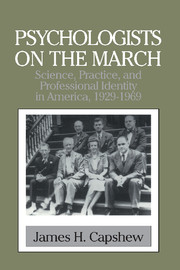Book contents
- Frontmatter
- Contents
- Acknowledgments
- List of Abbreviations
- Introduction: The Psychologists' War
- Interlude I
- 1 Growing Pains: After the Great War
- 2 Mobilizing for World War II: From National Defense to Professional Unity
- 3 Home Fires: Female Psychologists and the Politics of Gender
- Interlude II
- 4 Sorting Soldiers: Psychology as Personnel Management
- 5 Applied Human Relations: The Utility of Social Psychology
- 6 From the Margins: Making the Clinical Connection
- 7 Engineering Behavior: Applied Experimental Psychology
- Interlude III
- 8 A New Order: Postwar Support for Psychology
- 9 Remodeling the Academic Home
- Interlude IV
- 10 The Mirror of Practice: Toward a Reflexive Science
- 11 Beyond the Laboratory: Giving Psychology Away
- Interlude V
- Epilogue: Science in Search of Self
- Index
9 - Remodeling the Academic Home
Published online by Cambridge University Press: 06 July 2010
- Frontmatter
- Contents
- Acknowledgments
- List of Abbreviations
- Introduction: The Psychologists' War
- Interlude I
- 1 Growing Pains: After the Great War
- 2 Mobilizing for World War II: From National Defense to Professional Unity
- 3 Home Fires: Female Psychologists and the Politics of Gender
- Interlude II
- 4 Sorting Soldiers: Psychology as Personnel Management
- 5 Applied Human Relations: The Utility of Social Psychology
- 6 From the Margins: Making the Clinical Connection
- 7 Engineering Behavior: Applied Experimental Psychology
- Interlude III
- 8 A New Order: Postwar Support for Psychology
- 9 Remodeling the Academic Home
- Interlude IV
- 10 The Mirror of Practice: Toward a Reflexive Science
- 11 Beyond the Laboratory: Giving Psychology Away
- Interlude V
- Epilogue: Science in Search of Self
- Index
Summary
In May 1945, as the war was entering its final stages, Harvard president James Bryant Conant appointed a blue-ribbon panel to advise him on how to cope with the chaotic situation in psychology at the university. Like a set of competing fiefdoms, Harvard psychology was divided among several powerful figures and scattered across a number of administrative units. Christened the University Commission to Advise on the Future of Psychology at Harvard, the twelve-member group was headed by Rockefeller Foundation executive Alan Gregg, a physician, and included a number of prominent educators and psychologists. Rather than focus exclusively on the Harvard case, however, the group was charged with the broader task of determining “the place of psychology in an ideal university.” That Harvard might approximate the ideal and thereby provide a blueprint for the rest of the academic world was an unspoken assumption.
The commission labored for two years before publishing its report, The Place of Psychology in an Ideal University. The report contained few surprises, as it endorsed most of the changes that were already occurring in the postwar expansion of psychology. The group affirmed the notion that psychology was valuable for a wide variety of other fields and should be incorporated into professional training for education, medicine, business, law, theology, and engineering. It recommended that working contact between all psychologists on a campus be maintained and that training programs for applied psychologists be developed further.
- Type
- Chapter
- Information
- Psychologists on the MarchScience, Practice, and Professional Identity in America, 1929–1969, pp. 187 - 208Publisher: Cambridge University PressPrint publication year: 1999



